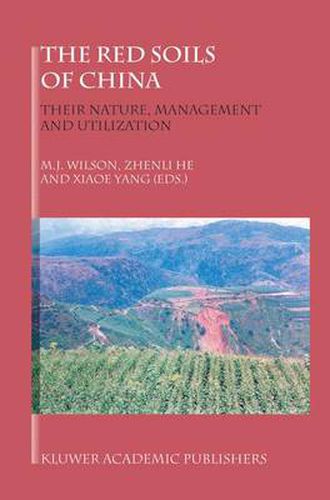Readings Newsletter
Become a Readings Member to make your shopping experience even easier.
Sign in or sign up for free!
You’re not far away from qualifying for FREE standard shipping within Australia
You’ve qualified for FREE standard shipping within Australia
The cart is loading…






This title is printed to order. This book may have been self-published. If so, we cannot guarantee the quality of the content. In the main most books will have gone through the editing process however some may not. We therefore suggest that you be aware of this before ordering this book. If in doubt check either the author or publisher’s details as we are unable to accept any returns unless they are faulty. Please contact us if you have any questions.
The red soils of China are highly weathered, inherently infertile and very susceptible to erosion. However, they represent China’s last available soil resource that could be brought into agricultural production, a fact that assumes great importance in view of China’s huge and still-increasing population. These soils are typical of similar red soils that occur throughout tropical and sub-tropical South America, Africa and south east Asia, so that if the red soils of China could be successfully utilized then this would have wider implications for agriculture in other countries. Previous attempts to cultivate Chinese red soils have met with little success and it has become apparent that they cannot sustain arable cropping systems without the most careful management. This book describes recent research outlining the physical, chemical and mineralogical nature of the soils, the various constraints that combine to inhibit their practical use, and the traditional and novel approaches that may be used to overcome these constraints. Building upon previous work and using examples from other countries, the book illustrates these approaches, shows appropriate land uses for the red soils of China and how the fertility of the soils evolves with time under these land uses. Whether these technical and scientific advances will be taken up by the Chinese farmer will depend to a large extent on the prevailing socio-economic conditions.
$9.00 standard shipping within Australia
FREE standard shipping within Australia for orders over $100.00
Express & International shipping calculated at checkout
This title is printed to order. This book may have been self-published. If so, we cannot guarantee the quality of the content. In the main most books will have gone through the editing process however some may not. We therefore suggest that you be aware of this before ordering this book. If in doubt check either the author or publisher’s details as we are unable to accept any returns unless they are faulty. Please contact us if you have any questions.
The red soils of China are highly weathered, inherently infertile and very susceptible to erosion. However, they represent China’s last available soil resource that could be brought into agricultural production, a fact that assumes great importance in view of China’s huge and still-increasing population. These soils are typical of similar red soils that occur throughout tropical and sub-tropical South America, Africa and south east Asia, so that if the red soils of China could be successfully utilized then this would have wider implications for agriculture in other countries. Previous attempts to cultivate Chinese red soils have met with little success and it has become apparent that they cannot sustain arable cropping systems without the most careful management. This book describes recent research outlining the physical, chemical and mineralogical nature of the soils, the various constraints that combine to inhibit their practical use, and the traditional and novel approaches that may be used to overcome these constraints. Building upon previous work and using examples from other countries, the book illustrates these approaches, shows appropriate land uses for the red soils of China and how the fertility of the soils evolves with time under these land uses. Whether these technical and scientific advances will be taken up by the Chinese farmer will depend to a large extent on the prevailing socio-economic conditions.